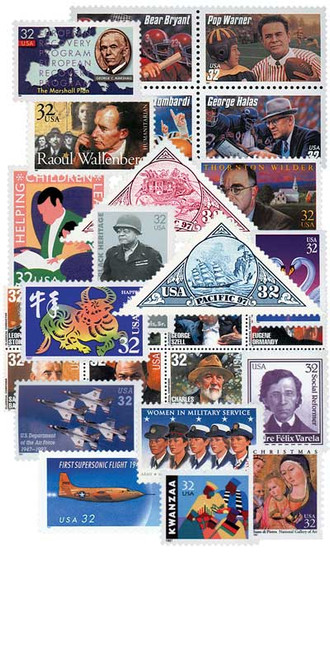
# 3131 FDC - 1997 32c Stagecoach
US #3131
1997 Stagecoach – Pacific ’97
- First US triangle issue (along with the Ship stamp)
- Publicized the Pacific ’97 international stamp show in San Francisco, California
Stamp Category: Commemorative
Set: ’Pacific 97
Value: 32¢, First Class Mail Rate
First Day of Issue: March 13, 1997
First Day City: New York, New York
Quantity Issued (if known): 130,000,000
Printed by: Banknote Corporation of America
Printing Method: Intaglio
Format: Triangular, Panes of 16 (4 blocks of 4)
Perforations: 11.2 by 11.3 (Wista stroke perforator)
Color: Red
Tagging: Phosphored Paper
Why the stamp was issued: To publicize the Pacific ’97 international stamp show in San Francisco, California.
About the stamp design: Pictures a stagecoach, one of the main 19th-century forms of transportation associated with the San Francisco area. The vignette is centered within an ornamented frame reminiscent of classic engraved stamps.
Special design details: Designed by USPS art director Richard Sheaff with ornamental frames originally commissioned for the 1996 Olympic Games centennial stamps. They were designed by John Thompson of Hellman Associates in Iowa. Sheaff then added vignettes based on illustrated covers from the mid-1800s. The engraving of the stagecoach is based on a drawing by Harrison Eastman (1823-1886), a post office clerk in San Francisco in 1849 until he became a painter, engraver, lithographer, and illustrator. Some small changes were made to the stagecoach image for use on this stamp.
First Day City: First Day of Issue Ceremony at the Postage Stamp Mega-Event at the New York Coliseum in New York City. The event was standing room only, and all 800 ceremony programs ran out before every attendee received one.
History the stamp represents: Stagecoaches played a vital role in postal history, providing the first scheduled mail service in modern times. In the early 1700s, England saw the dawning of the Industrial Revolution. And as economic activity increased, merchants clamored for a faster, more reliable mail system. To meet the demand, entrepreneurs initiated scheduled stagecoach services, while the government implemented a systematic road-building plan to develop a reliable transportation network.
Here in America, colonial postal service manager Benjamin Franklin followed England’s example and established scheduled mail service. By the mid-1700s, stagecoach and mail service linked the major cities of the East Coast. In 1840, the introduction of the world’s first postpaid, self-adhesive postage stamp – England’s Penny Black – further boosted economic activity.
Together, stagecoaches and postage stamps laid the foundation for a mail system that was fast, reliable, and efficient. Though stagecoaches were quickly replaced by railroads, they continued to provide vital services to inaccessible places into the 20th century.
US #3131
1997 Stagecoach – Pacific ’97
- First US triangle issue (along with the Ship stamp)
- Publicized the Pacific ’97 international stamp show in San Francisco, California
Stamp Category: Commemorative
Set: ’Pacific 97
Value: 32¢, First Class Mail Rate
First Day of Issue: March 13, 1997
First Day City: New York, New York
Quantity Issued (if known): 130,000,000
Printed by: Banknote Corporation of America
Printing Method: Intaglio
Format: Triangular, Panes of 16 (4 blocks of 4)
Perforations: 11.2 by 11.3 (Wista stroke perforator)
Color: Red
Tagging: Phosphored Paper
Why the stamp was issued: To publicize the Pacific ’97 international stamp show in San Francisco, California.
About the stamp design: Pictures a stagecoach, one of the main 19th-century forms of transportation associated with the San Francisco area. The vignette is centered within an ornamented frame reminiscent of classic engraved stamps.
Special design details: Designed by USPS art director Richard Sheaff with ornamental frames originally commissioned for the 1996 Olympic Games centennial stamps. They were designed by John Thompson of Hellman Associates in Iowa. Sheaff then added vignettes based on illustrated covers from the mid-1800s. The engraving of the stagecoach is based on a drawing by Harrison Eastman (1823-1886), a post office clerk in San Francisco in 1849 until he became a painter, engraver, lithographer, and illustrator. Some small changes were made to the stagecoach image for use on this stamp.
First Day City: First Day of Issue Ceremony at the Postage Stamp Mega-Event at the New York Coliseum in New York City. The event was standing room only, and all 800 ceremony programs ran out before every attendee received one.
History the stamp represents: Stagecoaches played a vital role in postal history, providing the first scheduled mail service in modern times. In the early 1700s, England saw the dawning of the Industrial Revolution. And as economic activity increased, merchants clamored for a faster, more reliable mail system. To meet the demand, entrepreneurs initiated scheduled stagecoach services, while the government implemented a systematic road-building plan to develop a reliable transportation network.
Here in America, colonial postal service manager Benjamin Franklin followed England’s example and established scheduled mail service. By the mid-1700s, stagecoach and mail service linked the major cities of the East Coast. In 1840, the introduction of the world’s first postpaid, self-adhesive postage stamp – England’s Penny Black – further boosted economic activity.
Together, stagecoaches and postage stamps laid the foundation for a mail system that was fast, reliable, and efficient. Though stagecoaches were quickly replaced by railroads, they continued to provide vital services to inaccessible places into the 20th century.








